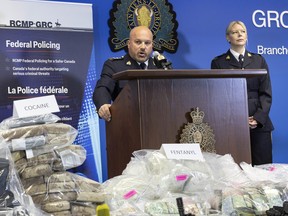Canadian organized crime groups have expanded internationally and remain a critical threat to the country’s security, a new report says.

Four criminal organizations based in Western Canada are considered high-level threats to the security of the country, according to a new report by Criminal Intelligence Service Canada.
The federal agency, which is responsible for collecting information from police across the country, said that “organized crime remains a preeminent threat to Canada’s security, contributing to thousands of deaths annually from overdoses due to illicit drugs, as well as firearms and gang violence.”
“Criminal organizations are mostly diverse and involved in multiple markets, making it increasingly important to assess organized crime by its impact through cooperative transnational networks, and consequently not to address the threat in isolation,” director general Ken Lamontague of the intelligence service said.
The high-level threat groups were not identified by name, but the descriptions of the western gangs mirror the B.C.-based Wolfpack gang alliance and the United Nations gang among others in the province.
One of the western gangs has a network extending across North America and into Central and South America, as well as into Europe, the report said.
“It is involved in fentanyl, cocaine, methamphetamine, money laundering, homicide and intimidation/extortion. … It is a prominent player in the gang conflicts.”
Another of the B.C. groups has connections across the continent and into the Caribbean, Europe and Oceania.
“It is involved in cocaine, methamphetamine, firearms, fraud, vehicle theft, money laundering, homicide, and intimidation. It has direct contact with transnational drug trafficking organizations who supply drugs and help coordinate logistics,” the report said.
The third high-risk B.C. criminal organization has a network across North America and into Asia.
“It is involved in cocaine, fentanyl, precursor chemicals, cannabis, fraud, money laundering, loansharking, bookmaking, and intimidation/extortion,” the annual report said. “It uses individuals with specialized skills, using a hierarchy of roles depending on the specific job to optimize the group’s overall proficiency.”

The fourth group described has leaders currently in custody — just like the Wolfpack — and appears to have the broadest scope extending “to various countries in North America, South America, Europe, Asia, and Oceania.”
“It is involved in fentanyl, methamphetamine, cocaine, firearms, money laundering, homicide, and intimidation. Despite the incarceration of several key members, it continues to operate at a high level, indicating that its operational redundancies are firmly in place.”
Postmedia revealed that a record-setting fentanyl super lab in Falkland, raided by the RCMP in October, was set up by the Wolfpack. High-profile members Damion Ryan and James Riach are currently in jail in Winnipeg and the Philippines respectively.
Three other organized crime groups based in Central Canada also topped the list of the 668 gangs assessed in the 2024 report.
The groups ranked high-level threats “are all highly capable, entrenched networks. They are involved in multiple criminal activities and have redundancies built into their operations to withstand market disruptions or fluctuations,” the intelligence service said.
“They exploit their networks and connections, both domestic and international, to maximize profits and extend their influence.”

The report also said that 128 of the organized crime groups are assessed as medium-level threats, while 533 were assessed as low-level threats.
The hundreds of groups analyzed are just some of the more than 4,000 criminal organizations believed to be operating in Canada.
Assessed groups “include a combined 12,075 criminal actors operating throughout the country, many of whom interact within more than one group. Extrapolating involvement to account for the number of unassessed (groups), criminal involvement could potentially currently consist of more than 70,000 individuals,” the report said.
The number of groups involved in manufacturing synthetic drugs almost doubled in a year from 51 in 2023 to 99 in 2024.
Of those, a third “are also involved in importing, highlighting the dependence of acquiring precursors chemicals from other source countries (primarily China) to domestically produce fentanyl and methamphetamine,” the report said.
Groups are shifting to the synthetic drug market in part due to record-low cocaine prices. Clandestine labs are primarily set up in B.C., Alberta, Ontario and Quebec.
“Eighty per cent of groups have collaborative links to others, either directly or via common associates,” it said.